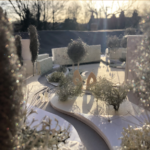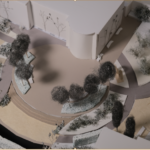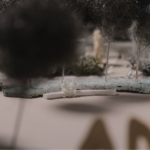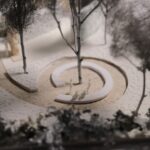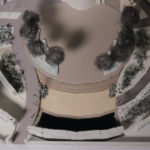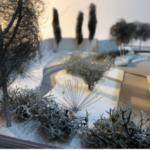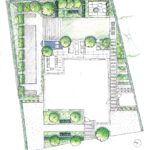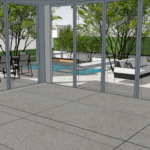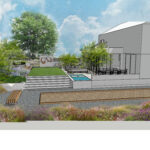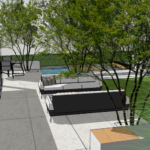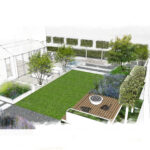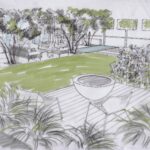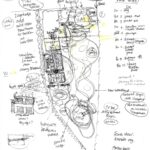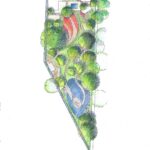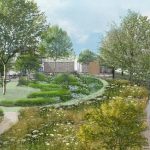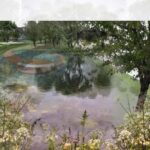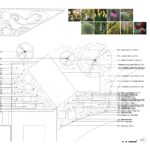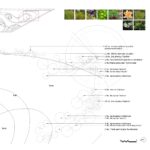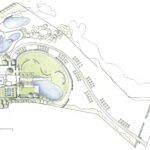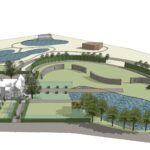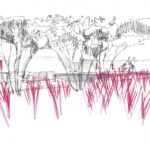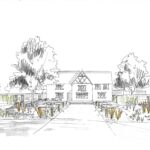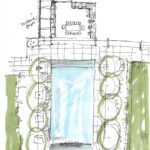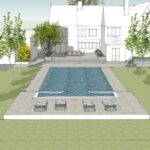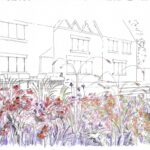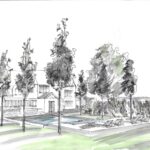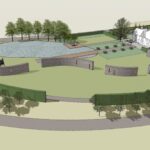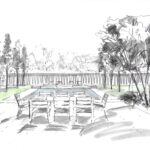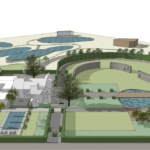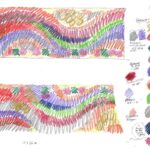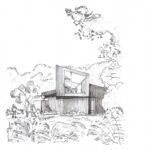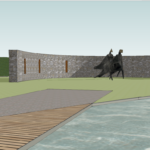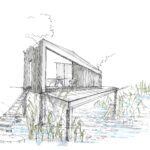Jacqui Chapman
My childhood memories are steeped in our 5-acre garden where I learnt the love of horticulture from parents who shared their interest and gave me my first garden space when I was 4. This early rapport with place developed into a strong relationship with landscape and an instinctive connection I trust. My intention is to offer this connection within imaginative design solutions combining both wild and managed spaces in historical and contemporary settings. My garden as a restorative mental sanctuary was a place I used to come to terms with a cancer diagnosis in 2017.
Research informs design to tell a garden’s own story and often integrates local vernacular so that there is a sense of place beyond a boundary. This includes its history or borrowed landscape, a respect for wildlife corridors, biodiversity, and sustainability using local materials where appropriate.
Each project is based on a unifying concept that reflects its potential and clients’ requirements and from which the design develops, often within a strong geometric framework. Spatial flow is an important element of each design guiding how a garden might be discovered. As an artist I imagine a garden as a canvas and use planting like brushwork contrasting loose textured repetition held by underlying structure so that a sense of movement creates changing atmospheres.
Images include a variety of model making, hand-drawing and CAD images to demonstrate my working process which is flexible.
Instagram: @jacquichapmangardendesign
Biography:
Art Direction and Fine Art Painting are a mix of previous work experience that enables me to realise richer more profound Garden Design spaces. I ‘think with my pencil’ and am confident drawing to communicate ideas. Classic design principles of composition, rhythm, form, texture, space, and colour from experience as a professional painter inform landscape decisions. Communication and creative project management experience in advertising as a senior art director for 13 years in award-winning international agencies provides many transferable skills in Garden Design working from a brief to creative concept within a budget and deadline heading professional teams of people to deliver a project.
The smallest of Kew Gardens’ wedding venue locations for hire, size inspired the idea for this garden as a ‘bijou’ meaning a small jewel in its crown. Visually the design is based on the concentric layers of a pearl’s creation emanating from a reception-room’s grand curved window of the Grade II listed building. A sense of theatre is achieved by introducing a level change that overlooks a curved reflective pool with fountains for a sense of occasion and where ceremonies take place. A new forest provides guests with a place to gather and socialise and sculpture gives the garden a sense of play and discovery linking areas. Tall Yew hedges screen views and give privacy whilst also exaggerating concentric forms within the garden.
The owners of this 1950’s property, an architect and interior designer, asked for an entertaining garden where they could integrate their new kitchen/dining extension with the garden, keep their view of Chesham Bois and play Bocce with their friends. They wanted an outdoor kitchen and a place to enjoy a G&T in the setting sun.
The solution splits the sloping garden into two levels, the upper terraces on the same level flowing out from the new extension onto the lawned garden area and the lower gravel area designed for Bocce. The sculptural 4.5 m limestone steps create the link and offer spatial flow between the levels with a cast concrete sculpture wall on the upper side of the garden to anchor the view.
The atmosphere beneath the multi- stemmed trees is enhanced by a reflective pool with low bubble jets and lighting for evening entertaining. The planting of this garden is romantic and frothy to contrast with the strong geometric layout using a blue/green palette on the upper level and minimal grasses on the lower terrace. Fragrant Rosa Desdemona perfumes the evening sun-trap with a fire pit offering a more intimate space for sundowners. The front garden is designed to have a sense of arrival with formality in the structure with screening from the road, parking for 4 cars and seasonal interest planting beneath Mangnolia Ghenie, a new exotic deep crimson variety.
The client’s newly acquired woodland runs the length of this property and the focus of the brief was to integrate it with the existing garden. This is a family garden, but also a business run from home needed consideration in terms of access and professional separation. There is a boggy area at the far end of the garden and the youngest emerging teenager needed a place to be with friends away from adults. They also wanted to keep an existing mature Beech tree and have a productive garden, parking and a sense of arrival.
My first visual site response is included. Notes, diagrams, wish list, potential on a drawing which becomes a ‘design roadmap’. Of ideas and intent. First impressions have that instinctive response but are not necessarily design solutions.
The existing Beech tree forms the geometric axis which takes your eye out from the balcony view and dining terrace and sweeps back through transitions of herbaceous and meadow planting to the house.
The office was turned away from the new terrace with reflective pond at 45 degrees. Accessed from a fragrant courtyard and with a view into the woods to create its own privacy, with a yoga deck and designed like a woodland cabin, ref Juvet Landscape Hotel. The boggy area became a large natural wild pond for swimming reached by curvilinear paths through the woods. Emily got a suspended pod in the trees. New entertaining areas have views through grass and herbaceous planting linking meadow, orchard and pools.
A 500m driveway leads into this 8.95 acre private property with original farmhouse and 60m lake with views across fields to medieval Beeston Castle. It is an impressive historical setting.
But nothing grows here. The south-westerly wind whips across the Cheshire Plains and for a garden to thrive here serious investment in shelter-belt fortification is needed. In real terms this is a new garden, an Eden, and that’s where the idea ‘Fortified Eden’ came about. Hedgerows as wildlife corridors with trees create new boundaries and castle iconography informs design detail using battlements with living walls and Yew boxes like crenelations.
An early tithe map (1854) showed a moat, existing lake and pool that confirmed my first response to make a water-garden here. These have different moods and treatment becomes more natural further from the house and includes a mere for birdwatching, typical of the wider Cheshire landscape.
Maintaining this as a private garden, its use is expanded as a creative retreat to include invited guests to meet monthly, reinstating the Bloomsbury ‘Friday Club’ to exchange ideas, work, and share a courtyard supper of homegrown fare and fine wine to reboot creative spirit. The sculpture wall offers exhibition space and the Creative Hub a place to work collaboratively with wild swimming in the natural pools to release creative energy and places for reflection along the way.

